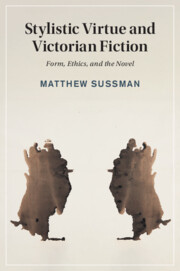Book contents
- Stylistic Virtue and Victorian Fiction
- Cambridge Studies In Nineteenth-Century Literature And Culture
- Stylistic Virtue and Victorian Fiction
- Copyright page
- Contents
- Illustrations
- Acknowledgments
- Introduction What Is Stylistic Virtue?
- Chapter 1 Stylistic Virtue and the Rise of Literary Formalism
- Chapter 2 Stylistic Virtue between Moralism and Aestheticism
- Chapter 3 Virtue Theory and the Nature of the Aesthetic
- Chapter 4 Thackeray’s Grace
- Chapter 5 Trollope’s Ease and Lucidity
- Chapter 6 Meredith’s Fervidness
- Afterword Stylistic Virtue and Literary Value
- Notes
- Bibliography
- Index
- Cambridge Studies In Nineteenth-Century Literature And Culture
Chapter 1 - Stylistic Virtue and the Rise of Literary Formalism
Published online by Cambridge University Press: 11 June 2021
- Stylistic Virtue and Victorian Fiction
- Cambridge Studies In Nineteenth-Century Literature And Culture
- Stylistic Virtue and Victorian Fiction
- Copyright page
- Contents
- Illustrations
- Acknowledgments
- Introduction What Is Stylistic Virtue?
- Chapter 1 Stylistic Virtue and the Rise of Literary Formalism
- Chapter 2 Stylistic Virtue between Moralism and Aestheticism
- Chapter 3 Virtue Theory and the Nature of the Aesthetic
- Chapter 4 Thackeray’s Grace
- Chapter 5 Trollope’s Ease and Lucidity
- Chapter 6 Meredith’s Fervidness
- Afterword Stylistic Virtue and Literary Value
- Notes
- Bibliography
- Index
- Cambridge Studies In Nineteenth-Century Literature And Culture
Summary
The first chapter argues that stylistic virtue was an important concept in British aesthetics that significantly influenced the development of formalism. It begins by examining the prevalence of stylistic virtues in eighteenth-century and early nineteenth-century rhetoric, where they were shaped by two approaches that mirror those described in the introduction: a psychological one that viewed style as extrinsic to textual content, and a belletristic one that emphasized the stylistic construction of aesthetic “character.” As the division between rhetoric and literary criticism began to harden, a new generation of Victorian critics co-opted the belletristic approach, placing the analysis of style at the heart of the emerging discipline of “English.” While some scholars have argued that Victorian readers were insensitive to style, this chapter reveals that wide-ranging figures such as Thomas De Quincey, Alexander Bain, David Masson, and Herbert Spencer each centered the aesthetic distinctiveness of literature around small-scale stylistic properties.
- Type
- Chapter
- Information
- Stylistic Virtue and Victorian FictionForm, Ethics, and the Novel, pp. 26 - 46Publisher: Cambridge University PressPrint publication year: 2021

